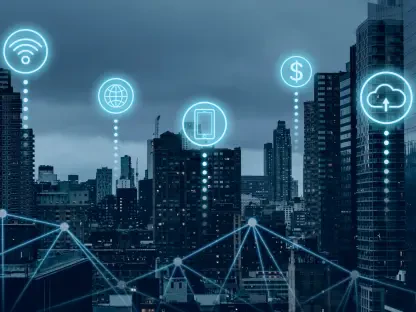In the ever-shifting landscape of cybersecurity threats, a new and formidable player has emerged, sending shockwaves through enterprises globally with its sophisticated approach. Charon ransomware, recently uncovered by cutting-edge research, represents a disturbing evolution in malware by fusing the destructive power of traditional ransomware with the calculated, stealthy techniques of Advanced Persistent Threat (APT) groups like Earth Baxia. Unlike typical ransomware that indiscriminately targets victims, Charon hones in on specific high-value sectors, such as the Middle East’s public sector and aviation industry, where operational disruptions can have catastrophic consequences. This hybrid approach signals a dangerous shift, as cybercriminals increasingly adopt sophisticated strategies once reserved for nation-state actors. What sets Charon apart is its uncanny resemblance to Earth Baxia’s tactics, from covert infiltration methods to precision targeting, raising alarms about the future of digital threats. This article delves into the intricate parallels between Charon and Earth Baxia, examining how this ransomware leverages APT-style maneuvers to maximize impact. By exploring its attack mechanisms, encryption strategies, and strategic focus, a clearer picture emerges of the challenges facing enterprise security. The discussion also sheds light on critical defensive measures needed to combat such evolving menaces, offering a roadmap for staying ahead in an increasingly hostile digital environment.
Stealthy Infiltration: A Page from Earth Baxia’s Playbook
Charon ransomware’s approach to infiltration is a striking mirror of Earth Baxia’s hallmark stealth, demonstrating a level of sophistication rarely seen in traditional ransomware campaigns. The attack begins with the exploitation of a legitimate binary, Edge.exe, which is used to sideload a malicious DLL known as msedge.dll or SWORDLDR. This loader decrypts an encrypted shellcode and injects the ransomware payload into svchost.exe, a trusted Windows service. Such tactics ensure that malicious activities remain hidden beneath the guise of normal system operations, making early detection incredibly challenging for conventional security tools. This multi-layered process is reminiscent of Earth Baxia’s methods, where the emphasis lies on evasion through blending into legitimate processes rather than relying on overt or noisy attacks. The deliberate use of process injection and DLL sideloading showcases an intimate understanding of enterprise systems and their potential vulnerabilities, a tactic often employed by APT groups to maintain persistence and avoid triggering alarms.
Further aligning with Earth Baxia’s covert strategies, Charon incorporates mechanisms designed to thwart endpoint security solutions. While currently dormant in analyzed variants, the presence of an embedded anti-Endpoint Detection and Response (EDR) driver, derived from publicly available projects, hints at future capabilities to disable protective measures. This forward-thinking approach to evasion parallels APT groups’ tendency to anticipate and neutralize defenses before launching full-scale attacks. Additionally, Charon’s ability to scan and encrypt network shares, while avoiding high-risk targets like ADMIN$ to minimize detection, reflects a calculated effort to spread laterally within networks—another trait shared with Earth Baxia’s espionage-driven operations. These similarities underscore a worrying trend where ransomware developers are not just seeking quick payouts but are investing in prolonged, undetected access to maximize disruption and leverage over their targets.
Ruthless Encryption and Disruption Tactics
When it comes to rendering data inaccessible, Charon ransomware employs encryption techniques that echo the meticulous and robust methods associated with Earth Baxia’s operations. The malware utilizes a hybrid cryptographic scheme, combining Curve25519 for key exchange with the ChaCha20 stream cipher for file encryption. This ensures that compromised data remains locked tight, with decryption virtually impossible without the attacker’s private key. To optimize efficiency, Charon applies partial encryption to larger files, targeting strategic chunks rather than entire datasets, while fully encrypting smaller files under 64KB. Encrypted files are marked with a .Charon extension and a distinct infection marker, further cementing the attacker’s control. Such precision in cryptographic design is a clear nod to the advanced techniques often seen in APT campaigns, where the goal is not just disruption but sustained dominance over compromised systems.
Beyond encryption, Charon’s approach to disrupting recovery options is strikingly similar to Earth Baxia’s ruthless playbook, aiming to leave victims with no viable alternatives but to negotiate. Before encrypting files, the ransomware systematically deletes shadow copies, empties the Recycle Bin, and terminates security-related services and processes. These actions are designed to cripple any chance of data restoration through standard recovery mechanisms, heightening the pressure on affected organizations. This calculated destruction mirrors APT strategies that prioritize eliminating fallback options to force compliance or extract maximum concessions. By integrating such disruptive measures, Charon elevates itself beyond a mere financial threat, positioning itself as a strategic weapon capable of inflicting long-term operational damage on targeted enterprises, much like the persistent threats posed by groups like Earth Baxia.
Precision Targeting: Echoes of Strategic APT Campaigns
Charon ransomware distinguishes itself from typical malware through its highly targeted approach, a characteristic deeply rooted in Earth Baxia’s strategic focus on specific, high-value victims. Unlike broad, opportunistic ransomware campaigns, Charon personalizes its attacks, with ransom notes tailored to include the victim organization’s name, indicating extensive pre-attack reconnaissance. This level of customization suggests that attackers invest significant time in understanding their targets, focusing on industries like aviation and government sectors in the Middle East, where data dependency and operational uptime are critical. Such precision targeting aligns closely with APT methodologies, where the objective is often to exploit entities with substantial stakes, ensuring higher potential payouts or strategic leverage. This deliberate selection of victims underscores a shift in ransomware tactics toward more calculated, impactful strikes.
Moreover, the personalized nature of Charon’s ransom notes, often titled “How To Restore Your Files.txt” and distributed across affected drives, amplifies the psychological impact on victims, a tactic reminiscent of Earth Baxia’s espionage-driven campaigns. This customization not only heightens the sense of violation but also signals to the victim that they are under a highly focused assault, increasing the likelihood of compliance. The emphasis on specific sectors further reflects APT groups’ tendency to prioritize targets based on geopolitical or economic significance, rather than casting a wide net for random hits. Charon’s ability to adapt its behavior through command-line parameters—such as targeting network shares or specific local paths—further demonstrates a tailored approach, allowing attackers to fine-tune their strategy based on the victim’s environment. This convergence of ransomware and APT tactics paints a grim picture of future threats, where specificity and intent play as crucial a role as technical prowess.
Implications for Enterprise Security and Defense Strategies
The emergence of Charon ransomware, with its clear emulation of Earth Baxia’s APT tactics, poses profound challenges for enterprise security, demanding a reevaluation of traditional defense mechanisms. The fusion of ransomware’s immediate financial motives with the long-term, stealthy goals of APT operations means that organizations face not only data loss and downtime but also potential prolonged infiltration. Industries like aviation, where operational continuity is paramount, are particularly vulnerable to the cascading effects of such targeted attacks. Financial repercussions extend beyond ransom demands, encompassing recovery costs, lost productivity, and potential regulatory penalties for data breaches. Additionally, reputational damage from publicized incidents can erode stakeholder trust, amplifying the long-term impact. Charon’s sophisticated evasion techniques reveal the inadequacy of reactive security postures, highlighting the urgent need for proactive, intelligence-driven strategies to counter hybrid threats.
To mitigate risks posed by Charon and similar threats, enterprises must adopt a multi-layered defense framework that addresses both technical and human vulnerabilities. Hardening systems against evasion tactics, such as monitoring for suspicious process chains or unsigned DLLs alongside legitimate binaries, can help detect initial compromise attempts. Protecting endpoint security solutions from tampering is equally critical, ensuring that EDR tools remain operational under attack. Limiting lateral movement within networks by restricting access to sensitive shares and enforcing robust authentication protocols can curb ransomware spread. Beyond technical measures, fostering user awareness through training on phishing and suspicious activity recognition remains a cornerstone of prevention. Implementing offline, immutable backups and regularly testing restoration processes ensures recovery options remain viable even if primary systems are compromised. Leveraging threat intelligence platforms to stay ahead of evolving tactics provides actionable insights, enabling organizations to anticipate and neutralize threats before they strike.
Navigating the Future of Hybrid Cyber Threats
Reflecting on the rise of Charon ransomware, it becomes evident that the boundaries between traditional malware and APT campaigns have significantly blurred. The meticulous adoption of Earth Baxia’s stealthy infiltration, disruptive encryption, and precision targeting by Charon marks a pivotal moment in the escalation of cyber threats. Enterprises find themselves grappling with a new reality where attackers combine immediate financial extortion with strategic, long-term objectives, leaving little room for complacency. The deliberate focus on high-value sectors and the calculated erasure of recovery options underscore a chilling intent to maximize both damage and leverage.
Looking ahead, the path to resilience lies in embracing a forward-thinking security posture that prioritizes adaptability and collaboration. Organizations should invest in continuous monitoring and threat intelligence to predict and preempt emerging tactics, ensuring defenses evolve in tandem with attacker innovations. Strengthening partnerships across industries to share insights and best practices can amplify collective resistance against hybrid threats. Additionally, integrating behavior-based detection alongside traditional signature-based tools offers a more dynamic shield against sophisticated evasion methods. As the digital battlefield grows more complex, the commitment to layered defenses, robust backup strategies, and ongoing education will be the linchpin in safeguarding critical assets. The lessons drawn from Charon’s campaign serve as a compelling reminder that staying ahead requires not just reaction, but anticipation and strategic foresight in an era of relentless cyber evolution.









